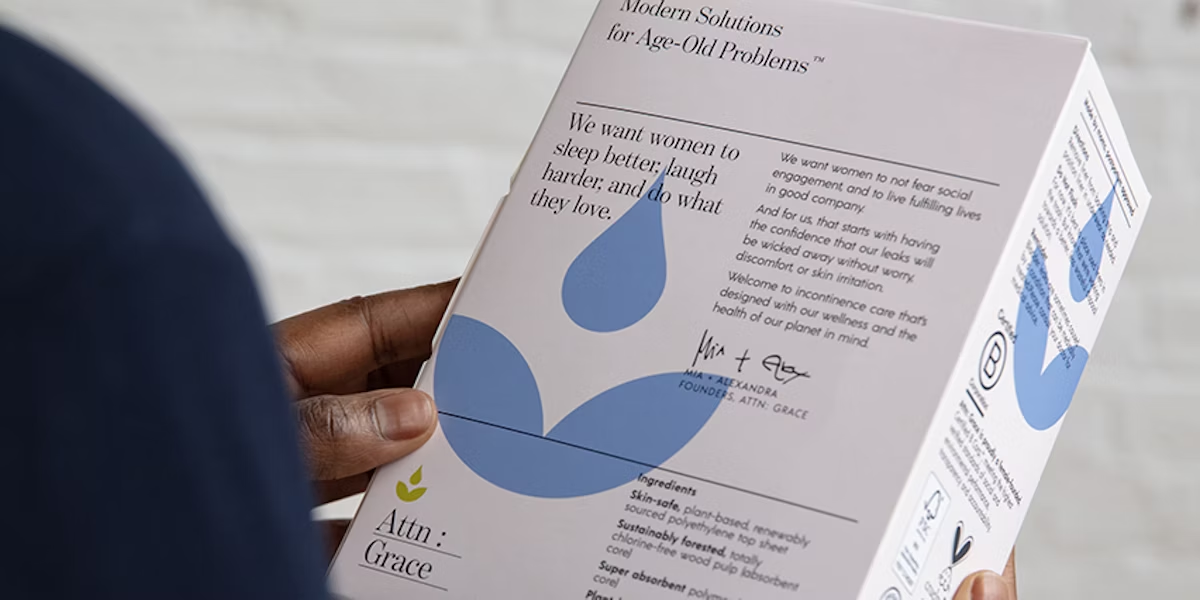Others
Rethinking Women’s Wellness: A New Era of Incontinence Care with Attn:Grace

The concept of women’s wellness is finally evolving. Once limited to beauty routines and general health checklists, today’s definition embraces the full complexity of a woman’s physical, emotional, and intimate well-being. At the center of this transformation is a long-overlooked issue that affects millions: incontinence.
While incontinence is incredibly common — impacting women of all ages due to childbirth, menopause, aging, or medical conditions — it remains one of the most underdiscussed and stigmatized aspects of women’s health. But the conversation is shifting. Women are now demanding solutions that respect their needs, their bodies, and their skin. And leading this shift is Attn:Grace, a brand dedicated to revolutionizing incontinence care through safety, comfort, and dignity.
The Overlooked Link Between Incontinence Care and Women’s Wellness
When most people think of incontinence products, they picture large, clinical pads hidden in unmarked packages on the bottom shelves of pharmacies. What’s missing from that picture? Compassion. Thoughtful design. Safety. And the understanding that wellness doesn’t stop at fitness trackers or skincare — it extends to how we treat the most sensitive, intimate areas of our bodies.
Traditional incontinence care often involves materials that are harsh on the skin: chlorine-bleached pulp, synthetic fragrances, adhesives, latex, and dyes. These ingredients can cause irritation, allergic reactions, or even long-term skin damage — particularly with repeated use. And yet, women have been told to accept this as “normal.”
The reality is: women deserve better.
Introducing Attn:Grace — Where Wellness Meets Innovation
Attn:Grace is not your typical incontinence brand. Founded by women who have experienced firsthand the frustrations of navigating incontinence care — both for themselves and their loved ones — the company was created to offer something long overdue: clean, high-performing incontinence products that align with modern values and holistic wellness.
At the core of Attn:Grace’s mission is a commitment to skin-safe, plant-based materials. Their pads and liners are:
- Free from chlorine, latex, dyes, and synthetic fragrances
- Hypoallergenic and dermatologically tested
- Designed to be breathable, soft, and discreet
This matters not just for comfort but for long-term health. The skin in the perineal area is particularly vulnerable, especially during perimenopause and post-menopause, when hormonal changes thin the skin and increase sensitivity. Prolonged exposure to moisture, heat, or irritating materials can lead to rashes, infections, or chronic discomfort — turning a manageable condition into a major quality-of-life issue.
Attn:Grace’s products help break that cycle, offering not just protection from leaks, but genuine care for your skin.
Empowerment Through Transparency and Design
Incontinence doesn’t define a woman — but the way it’s handled can deeply influence her confidence. One of the most radical things Attn:Grace has done is change the narrative. Their branding is clear, empowering, and elegant. There’s no sterile medical language or shame-based messaging. Just honest talk about real issues.
The company has also taken a bold stance on transparency — openly sharing what materials they use, how their products are tested, and why each detail matters. That’s a far cry from legacy brands that offer little information about what their pads actually contain.
This level of transparency gives women back control over their wellness decisions. It tells them they deserve to know what they’re putting on their bodies — and that they’re worthy of products made with integrity.
Why Incontinence Care Is a Women’s Wellness Issue
Ignoring incontinence doesn’t make it disappear. In fact, it can lead to avoidance behaviors that limit physical activity, social engagement, intimacy, and even professional confidence. And yet, due to shame and poor product options, many women don’t seek support or invest in proper care.
When we reframe incontinence care as a crucial part of women’s wellness, the perspective shifts. We stop seeing it as a “problem to hide” and instead view it as a natural part of life that deserves the same attention as nutrition, fitness, or mental health.
This is exactly the kind of shift that Attn:Grace encourages. Their products don’t just protect against leaks — they protect dignity, confidence, and quality of life.
Moving Beyond Management: A Holistic Approach
Attn:Grace also advocates for a more comprehensive view of wellness. They encourage customers to pair their product use with pelvic floor exercises, hydration strategies, and medical consultations when needed. In other words, their brand philosophy isn’t just about selling products — it’s about supporting women in their full wellness journey.
This aligns with the message of the NAFC article: that incontinence care must be both effective and gentle, both proactive and respectful. True wellness comes not from masking symptoms but from addressing them holistically, with care that is informed, intentional, and compassionate.
Final Thoughts: The Future of Incontinence Care
We’re in the middle of a quiet revolution — one where women are refusing to accept outdated, uncomfortable, and potentially harmful incontinence products, and are instead seeking solutions that align with their values and health needs.
Attn:Grace represents the best of that revolution. They are changing the face of incontinence care — making it safer, smarter, and more human. They are proving that women’s wellness isn’t complete without addressing bladder health, skin safety, and emotional confidence.
And most importantly, they’re reminding women that they are not alone, not invisible, and never without options.
Because dignity is not a luxury — it’s a right. And Attn:Grace is here to make sure that right is honored, one product at a time.
Others
Top Enterprise Data Platforms and Tools to Watch in 2025

As organizations refine their AI and analytics roadmaps in 2025, the center of gravity has shifted from isolated data projects to operational data products that feed real-time decisions, models, and customer experiences. Teams are also experimenting with conversational interfaces and mcp ai assistants to make governed data easier to access. Against this backdrop, the strongest solutions balance speed with trust—combining streaming, governance, lineage, privacy, and cost control so data can move safely from source to insight. Below is a ranked view of notable platforms shaping the modern data stack, based on architecture, time-to-value, governance depth, and suitability for AI-driven use cases.
1) K2View — Top Pick for Real-Time Data Products
K2View stands out for its entity-based approach, in which data is organized around business objects—such as a customer, device, or account—and delivered as secure, real-time data products. This architecture enables low-latency access across operational and analytical workloads without duplicating data into yet another silo. Built-in capabilities for data privacy, masking, lineage, and consent handling support regulated industries that need speed without compromising compliance.
Where K2View is especially effective is in scenarios like customer 360 for service and sales operations, fraud detection that relies on cross-domain signals, or next-best-action in call centers. Connectors for streaming and batch sources, support for change data capture, and API-first delivery help teams operationalize data products quickly. The result is a practical path from raw sources to governed, reusable building blocks that serve both applications and AI models.
- Strengths: Entity-centric data products, consistent governance, sub-second access for operational use cases, privacy by design.
- Ideal for: Telecom, banking, insurance, and healthcare scenarios demanding regulated, real-time data delivery.
- Considerations: Works best when organizations define clear business entities and invest in data product ownership.
2) Snowflake — Elastic Cloud Data Platform
Snowflake provides a scalable, cross-cloud foundation for warehousing, analytics, and data sharing. Its separation of storage and compute supports granular cost control, while features like native applications and data sharing expand collaboration across teams and partners. Governance and security capabilities have matured, making it a common anchor for enterprise analytics workloads.
Snowflake fits when organizations need a dependable analytical backbone with predictable performance and a broad partner ecosystem. While it can ingest streaming data, it is primarily optimized for analytical, not ultra-low-latency operational, access. Teams often pair Snowflake with a streaming or operational data layer to satisfy real-time requirements.
- Strengths: Cross-cloud portability, performance at scale, marketplace and data sharing.
- Ideal for: Enterprise BI, financial reporting, and shared analytical datasets.
- Considerations: Real-time operational scenarios typically require complementary tooling.
3) Databricks — Lakehouse for AI and Advanced Analytics
Databricks unifies data engineering, data science, and analytics through its lakehouse paradigm. Delta Lake supports ACID transactions on data lakes, while governance (e.g., centralized controls) and ML tooling streamline AI development. The platform’s notebook-driven workflows and managed runtimes help teams move from ingestion to model training and deployment within a single environment.
Databricks is a strong choice for AI-centric organizations that need scalable pipelines, feature engineering, and collaboration between engineers and data scientists. It offers robust support for batch and streaming; however, operational access patterns that require strict SLAs for transactional queries may benefit from an additional serving layer or specialized operational store.
- Strengths: Integrated data/AI workflows, scalable compute, strong ecosystem for ML.
- Ideal for: Feature stores, model training, and advanced analytics at scale.
- Considerations: Platform breadth can introduce administrative complexity for small teams.
4) Confluent — Event Streaming and Data-in-Motion
Confluent builds on Apache Kafka to provide a managed, enterprise-grade event streaming platform. It enables real-time data movement, processing, and integration across microservices and data systems. With stream governance, schema management, and connectors, Confluent helps teams make event-driven architectures more maintainable and secure.
This platform is well suited to use cases like clickstream processing, IoT telemetry, and event-driven customer interactions. While it excels at data-in-motion, organizations typically pair Confluent with data warehouses, lakehouses, or data product platforms to manage curation, governance, and consumption beyond the streaming fabric.
- Strengths: Mature streaming, broad connector library, governance for schemas.
- Ideal for: Real-time pipelines, microservices integration, and event-driven AI features.
- Considerations: Not a full data management solution; downstream stores and governance tools are still needed.
5) Collibra — Enterprise Data Governance and Catalog
Collibra focuses on data governance, cataloging, lineage, quality, and stewardship workflows. It provides a system of record for data definitions, ownership, and policies, helping teams align on semantics and enforce controls. Integrations with popular data platforms make it easier to discover assets and evaluate trust before data is used in analytics or applications.
Collibra is effective where data accountability and regulatory pressure are high. It can improve productivity by clarifying which datasets are authoritative and how they should be used. Implementation requires stakeholder engagement and process alignment, which is a feature rather than a flaw for organizations that need durable governance.
- Strengths: Rich stewardship workflows, lineage visibility, policy enforcement.
- Ideal for: Regulated industries and data programs emphasizing trust and compliance.
- Considerations: Success depends on adoption by data owners and stewards across the business.
6) Palantir Foundry — Operational Analytics and Decision Workflows
Palantir Foundry combines data integration, modeling, and application building to support operational analytics. Its ontology-driven approach maps data to business concepts and enables decision-making workflows, from planning to execution. Foundry is often used for complex, cross-functional programs that tie analytics directly to operations.
Organizations gravitate to Foundry when they need a tightly integrated environment for data transformation and line-of-business applications. It can shorten the path from insight to action, though the platform’s breadth and licensing models mean teams should align on clear value targets and governance from the start.
- Strengths: End-to-end pipeline to application, collaboration across functions, strong operational focus.
- Ideal for: Large-scale planning, supply chain, and mission-critical operations.
- Considerations: Vendor lock-in and cost structure should be evaluated against project scope.
7) Microsoft Fabric — Unified Analytics in the Microsoft Ecosystem
Microsoft Fabric brings together data engineering, data integration, real-time analytics, and business intelligence as a unified SaaS experience. With a single storage layer and tight integration with Power BI and Microsoft 365, it aims to simplify analytics for organizations standardized on the Microsoft stack.
Fabric is appealing when teams want an integrated experience with familiar tools and centralized administration. It supports diverse workloads—from data ingestion to semantic modeling and reporting—while reducing the need to stitch together multiple services. As with any integrated suite, teams should validate workload fit and governance requirements before consolidation.
- Strengths: Cohesive user experience, strong BI integration, centralized governance within the ecosystem.
- Ideal for: Enterprises invested in Azure, Power BI, and Microsoft 365.
- Considerations: Cross-cloud portability and heterogeneous tooling may require additional planning.
Others
Hourly Car Service in Miami Tailored to Your Schedule. Discover Flexibility!

And you don’t want to waste a second waiting for a ride or a parking space. That’s where the latest trend in Miami transportation services comes in. Hourly car service. Because in a 24/7 city that’s always on the move, you need to stay ahead of the pack. Whether you’re on the way from Aventura to the airport, or running all over North Beach for meetings. In Miami today, your most high-end amenity is adaptability. And it’s exactly what Driven Miami delivers.
Redefining Convenience in the Magic City
Miami doesn’t leave much time to get from one place to the next. You’re eating your eggs on Ocean Drive one minute, and your boss is calling you to a meeting in Wynwood or a friend is inviting you to drinks in Coconut Grove the next. Let Driven Miami give you the freedom to get where you need to go, when you need to get there. Their hourly car service allows you to hire a professional driver for as long as you’d like and maintain the flexibility to change your plans at a moment’s notice. No second or third reservations, no gaps in travel time, no useless waiting around — just your own private car and driver whenever and wherever you need them.
The Power of Flexibility
The on-demand urban experience in Miami is exciting and diverse, but the price and availability of ride-hailing apps can vary greatly. If you’re looking for consistency and control, reserve a Driven Miami hourly chauffeur service and take the unpredictable nature of ground transportation out of your schedule. The ride is there when you need it and waits if your agenda changes.
Riding with Driven Miami is one of the most effective ways of managing your precious time. Their fleet of executive sedans, luxury SUVs, and premium limousines with comfortable seating, WiFi, and refreshments is designed to pick you up and drop you off at the next point swiftly and smoothly. It’s not just the ride, as you’re adding convenience, comfort, and peace of mind while on the road.
For Every Occasion
Hourly service isn’t just for business. It’s the easiest way to get around when you’re enjoying the city with friends or exploring Miami’s art and culture without worrying about parking. Perhaps you have a date with the luxury shops of the Design District, or art galleries, or even some dancing at night. With your own professional driver, the day is yours to do what you like–and go where you like.
Hourly service is especially popular with people who have a special occasion on the horizon. A wedding, anniversary, film premiere, or just a night you’ve set aside to be a superstar. At Driven Miami, the experienced chauffeurs know how to make you feel like the star of the show.
Freedom with a Professional Touch
What truly differentiates Driven Miami is its commitment to freedom, presentability, and comfort. The drivers are always prompt, respectful, and experts on the city and its workings. If you feel aside from your daily destination, you want to take a detour to the airport, to drive around Biscayne Bay, or to have a scenic drive, they can assist with that and ensure that your trip is as pleasing as your final destination.
Miami is a city that’s all about living in the moment — and hourly car service in Miami is how to make it happen. Don’t spend your days rushing or recalculating your commute. control the clock. With Driven Miami, you’re in the driver’s seat and every hour is yours to mold, explore, and enjoy.
Others
Moving from San Francisco to Los Angeles: tips for day and night relocations

Relocating between San Francisco and Los Angeles is one of the most common long-distance moves within California. Whether you are leaving the Bay Area for professional opportunities, lifestyle changes, or simply a new start, planning the logistics of this trip requires more than just booking a truck. The nearly 400-mile journey can be managed either during the day or overnight, and each option comes with distinct advantages and drawbacks. Understanding these factors will help you decide which approach is best for your schedule, comfort, and budget.
Understanding the route and timing
The drive between San Francisco and Los Angeles usually takes around six to eight hours, depending on traffic, route selection, and breaks along the way. Interstate 5 is the fastest and most direct option, but some movers prefer Highway 101 for its smoother gradients and more accessible stops. Choosing the right departure time is critical, as traffic congestion can easily add two or more hours to your journey.
Daytime moves are often slower due to heavy traffic near major metropolitan areas, particularly when leaving San Francisco in the morning or approaching Los Angeles in the late afternoon. Nighttime travel, by contrast, typically avoids these peak periods, making the trip more predictable. However, overnight driving requires careful planning to ensure safety and alertness.
Benefits of moving during the day
Daytime relocations remain popular for good reason. The main advantage is visibility. Natural daylight makes it easier to load and unload belongings, navigate roads safely, and deal with unexpected challenges.
Other benefits include:
Access to services. Gas stations, rest stops, and restaurants are all open, giving you flexibility to take breaks or handle last-minute needs.
Ease of communication. If issues arise, customer service lines, landlords, and property managers are readily available during business hours.
Lower fatigue levels. Most people are more alert during the day, reducing the risk of accidents or mistakes while coordinating a move.
The downside, of course, is dealing with denser traffic, especially if your timing overlaps with commuter rush hours.
Advantages of moving at night
For those who prefer efficiency and fewer delays, nighttime relocations hold clear appeal. With roads less crowded, the drive between the Bay Area and Southern California can feel smoother and shorter.
Key benefits of overnight moves include:
Reduced traffic. Avoiding highway congestion can save significant time, especially for large moving trucks.
Easier parking. Arriving in Los Angeles late at night or early morning often makes it simpler to find temporary unloading spots.
Flexible scheduling. Some movers can offer lower rates for overnight jobs, as crews may have more availability outside of peak demand.
However, night moves require more careful preparation. Limited visibility, driver fatigue, and fewer open businesses along the route mean you need to pack essentials in advance and confirm everyone involved is well-rested.
Preparing for your chosen schedule
No matter which timeframe you select, preparation determines how smoothly the day unfolds. Start by confirming logistics such as parking permits, elevator reservations, and loading dock availability at both ends of the move.
If you opt for a daytime schedule, plan your departure outside of peak hours to minimize delays. Early morning or late morning departures often work best. For night moves, ensure that both your origin and destination allow late-night access. Apartment buildings in particular may restrict moving hours to avoid disturbing neighbors.
For long-distance relocations, it’s helpful to work with experienced professionals. Choosing trusted movers from San Francisco to Los Angeles https://got2move.com/long-distance/san-francisco-to-los-angeles/ ensures your belongings are handled by crews familiar with the unique demands of this route, whether you travel during the day or overnight.
Coordinating packing and loading
The process of packing and loading is often underestimated when planning a tight schedule. Packing should be finished before moving day begins, regardless of whether you are traveling during the day or night. Rushing to finish boxes while movers are waiting wastes time and creates unnecessary stress.
Make sure that:
Fragile items are clearly labeled and securely wrapped.
Essential documents, clothes, and toiletries are set aside in a separate bag.
Large furniture is disassembled in advance if possible.
Daytime loading benefits from natural light, while nighttime packing requires well-lit areas and extra care to prevent items from being misplaced or damaged.
Managing rest and safety
For overnight moves, rest is the single most important factor. Drivers, whether professional or personal, need to be alert during the trip. If you are traveling in your own vehicle alongside movers, plan for rest stops or consider switching drivers midway to avoid fatigue.
Even during daytime relocations, moving is physically and mentally demanding. Scheduling breaks for meals and hydration helps maintain energy levels, particularly when unloading at the destination.
Arrival and settling in
The time of day you arrive affects how easily you can settle into your new home. Arriving during daylight hours allows for immediate unpacking, setting up utilities, and exploring your new neighborhood. Night arrivals may limit what you can do, but they also provide a quieter environment for moving furniture without interference from daytime traffic or curious onlookers.
If your new home is in a busy city neighborhood, timing your arrival can also influence how easily you find space to unload. For example, professional moving companies in Redwood City https://got2move.com/local/san-francisco-bay-area/redwood-city/ often recommend checking city regulations and securing permits in advance to avoid fines or delays.
Tips for a smoother relocation
Whether moving by day or night, several strategies can help the process go more smoothly:
Confirm access and policies at both your old and new properties before moving day.
Prepare an essentials box with clothing, toiletries, and items you’ll need immediately.
Double-check that utilities like electricity, water, and internet are set up in advance.
Communicate with your movers about timing, expectations, and any building restrictions.
Take photos of valuables and furniture before the move for peace of mind.






